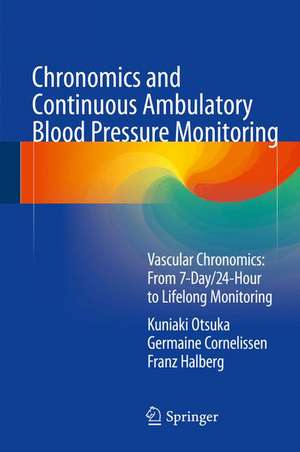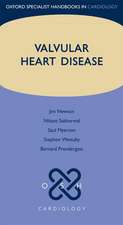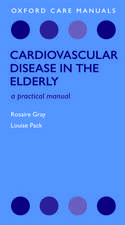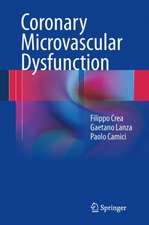Chronomics and Continuous Ambulatory Blood Pressure Monitoring: Vascular Chronomics: From 7-Day/24-Hour to Lifelong Monitoring
Autor Kuniaki Otsuka, Germaine Cornelissen, Franz Halbergen Limba Engleză Hardback – 17 mar 2016
| Toate formatele și edițiile | Preț | Express |
|---|---|---|
| Paperback (1) | 952.94 lei 38-44 zile | |
| Springer – 24 apr 2018 | 952.94 lei 38-44 zile | |
| Hardback (1) | 1377.56 lei 38-44 zile | |
| Springer – 17 mar 2016 | 1377.56 lei 38-44 zile |
Preț: 1377.56 lei
Preț vechi: 1450.06 lei
-5% Nou
Puncte Express: 2066
Preț estimativ în valută:
263.68€ • 286.51$ • 221.63£
263.68€ • 286.51$ • 221.63£
Carte tipărită la comandă
Livrare economică 17-23 aprilie
Preluare comenzi: 021 569.72.76
Specificații
ISBN-13: 9784431546306
ISBN-10: 4431546308
Pagini: 500
Ilustrații: LXXV, 870 p. 644 illus., 275 illus. in color.
Dimensiuni: 155 x 235 x 56 mm
Greutate: 1.97 kg
Ediția:1st ed. 2016
Editura: Springer
Colecția Springer
Locul publicării:Tokyo, Japan
ISBN-10: 4431546308
Pagini: 500
Ilustrații: LXXV, 870 p. 644 illus., 275 illus. in color.
Dimensiuni: 155 x 235 x 56 mm
Greutate: 1.97 kg
Ediția:1st ed. 2016
Editura: Springer
Colecția Springer
Locul publicării:Tokyo, Japan
Public țintă
Professional/practitionerCuprins
Dedication.- Acknowledgements.- Preface.- Chapter 1: From chronobiology to chronomedicine: Days of creation.- Chapter 2: From chronomics to chronoastrobiology: Many rhythms are control information for whatever we do.- Chapter 3: Chronobioethics: what is life?.- Chapter 4: Chronobiology.- Chapter 5: Chronomics of heart rate variability.- Chapter 6: Chronomics of life for improving the quality of health.- Chapter 7: Chronomics of tree rings gauge climate change.- Chapter 8: Introduction to Chronobioengineering.- Chapter 9: What community-based glocal comprehensive assessment tells us: chronoecology is far superior to evidence-based medicine (EBM).- Chapter 10: Community-based comprehensive geriatric assessment.- Chapter 11: Chronomic community screening: depressive mood, heart rate variability and cardiovascular outcomes in a community.- Chapter 12: Chronoecological “glocal” (global and local) comprehensive health-watch at high altitude.- Chapter 13: Chronoastrobiology.- Chapter 14: Heart rate variability reflecting the dynamics of solar activity.- Chapter 15: A transdisciplinary near-transyear in sudden cardiac death validates its counterpart in the solar wind and geomagnetics.- Chapter 16: Diagnosing vascular variability disorders and vascular variability syndromes.- Chapter 17: Among-day blood pressure variability assessed by 7-day/24-hour ambulatory blood pressure monitoring and prognostic value of vascular variability anomalies.- Chapter 18: Case presentations I. Within-day BP variations observed using 7-day/24-hour ambulatory BP monitoring.- Chapter 19: Case presentations II. Vascular variability syndrome.- Chapter 20: Case presentations III. Among-day variability of circadian profiles of 24-hour ABP.- Chapter 21: "What is life?" Cycles tipping the scale between death and survival.- Chapter 22: Astro-glocal spatially and temporally (global & local) comprehensive health watch especially at high altitude.- Chapter 23: Chronobioethics and Alerting Chronobiological Ambulatory Blood Pressure Monitoring (C-ABPM; stress/strain-test) For preventing cardiovascular and for understanding and avoiding/evading societal and natural cataclysms by personalized and generalized chronouspheres.- Closing Remarks.
Notă biografică
Dr. Kuniaki Otsuka obtained PhD degree in Division of Medicine, Kyusyu University Graduate School, Japan in 1981.He started his carrier as an assistant Professor at Kyusyu University in 1973.He moved to Tokyo woman’s medical School as a lecturer in 1987 and promoted to full Professor in 1998. He started his research on Chronobiology in 1987, supervised by Dr. Halberg at Minnesota University. He is one of the top researcher in this field, as he received Halberg Prize at 3rd International Workshop on Circadian Rhythms&Clinical Chrono therapy in 2002 and he organized 2nd World Congress of Chronobiology as an president in 2007.
Textul de pe ultima copertă
This fascinating volume applies the concept of chronomics to the medical treatment of hypertension. It starts with the recent updates on chronomics, the analytic techniques, and their application to community-based assessments. The authors advocate the use of 7-day/24-h records of blood pressure, which is effective for finding masked hypertension, masked morning surge, and other rhythm abnormalities. Most organisms, from cyanobacteria to mammals, are known to use the circadian mechanism. However, our body systems also demonstrate circaseptan (roughly weekly), circannual (roughly yearly), and even longer rhythms. Chronomics monitors the physiological data and then analyzes the superimposed rhythms, isolating the cycles mathematically to determine how organisms and their environment interact. It is the study of interactions among time structures (chronomes) in and around us.
Caracteristici
Applies the idea and analysis technique of chronomics to the medical treatment of hypertension
Includes a wealth of data and graphs collected from field studies
Will benefit clinicians who want to increase the efficiency of blood pressure analysis and medical treatment, as well as research scientists who are interested in chronomics
Includes a wealth of data and graphs collected from field studies
Will benefit clinicians who want to increase the efficiency of blood pressure analysis and medical treatment, as well as research scientists who are interested in chronomics












